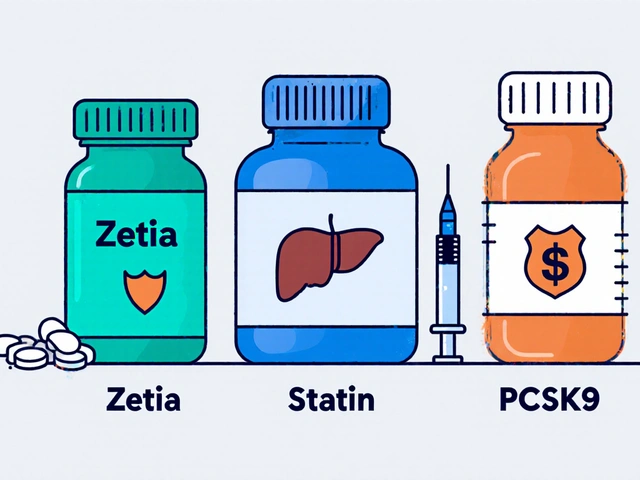Furosemide is a potent loop diuretic used to remove excess fluid in conditions like heart failure, hypertension, and edema. It works by blocking sodium‑potassium‑chloride transport in the thick ascending limb of the loop of Henle, leading to increased urine output. Because of its rapid action and narrow therapeutic window, getting the furosemide dosage right is crucial for both efficacy and safety.
TL;DR - Quick Reference
- Oral adult start: 20‑80mg once or twice daily; increase by 20‑40mg increments.
- IV adult bolus: 20‑40mg; repeat every 1‑2hours if needed.
- Renal impairment: start low (10‑20mg) and adjust based on urine output and electrolytes.
- Children: 0.5‑2mg/kg per dose, max 6mg/kg/day.
- Monitor potassium, sodium, creatinine, and blood pressure closely.
What Makes Furosemide a Loop Diuretic?
Loop diuretic is a class of medication that targets the loop of Henle, the nephron segment responsible for reabsorbing about 25% of filtered sodium. By inhibiting the Na⁺/K⁺/2Cl⁻ cotransporter, furosemide creates a strong osmotic gradient, pulling water into the tubular lumen. Compared with thiazide diuretics, loop diuretics are ten times more potent and work even when renal function is reduced.
Key Clinical Indications
Furosemide is prescribed for several high‑impact conditions:
- Acute heart failure - rapid decongestion improves breathing and cardiac output.
- Chronic kidney disease (CKD) - helps manage volume overload when glomerular filtration rate (GFR) falls below 30mL/min.
- Hypertension - especially when resistant to other agents.
- Peripheral edema - from liver cirrhosis, nephrotic syndrome, or medication‑induced fluid retention.
Adult Dosing Basics
Dosage depends on the route, the indication, and the patient’s renal function.
Oral Administration
- Initial dose for most adults: 20‑80mg once or twice daily.
- For severe edema or rapid diuresis, a loading dose of 80mg may be given, followed by maintenance.
- Increase by 20‑40mg every 24hours until the desired urine output (0.5‑1mL/kg/hr) is achieved.
- Maximum recommended total daily dose: 600mg (split doses).
Intravenous (IV) Bolus
- Typical bolus: 20‑40mg over 1‑2minutes.
- Repeat every 1‑2hours if fluid removal is insufficient.
- Continuous infusion: 0.5‑2mg/kg/hr; useful in ICU settings.
Special Populations
- Elderly patients often have reduced renal clearance, so start ½‑⅔ of the usual dose.
- Patients with hypoalbuminemia (serum albumin < 3g/dL) may require higher doses because furosemide is highly protein‑bound.
Pediatric Dosing
Children are not just small adults; dosing follows weight‑based calculations.
- Neonates (≤28days): 1‑2mg/kg/dose IV or oral, max 6mg/kg/day.
- Infants and children (>28days): 0.5‑2mg/kg/dose every 6‑12hours, not to exceed 6mg/kg/day.
- For congenital heart disease with fluid overload, a slightly higher initial bolus (2‑4mg/kg) may be used under close monitoring.
Renal‑Adjustment Strategies
Kidney function is the single biggest determinant of how much furosemide the body can handle.
- When GFR < 30mL/min, start with 10‑20mg IV or oral and titrate slowly.
- In end‑stage renal disease on dialysis, doses of 40‑80mg IV after each dialysis session are common to maintain euvolemia.
- For patients on hepatic impairment, no dose change is required, but watch for hypo‑albuminemia‑related distribution changes.

Monitoring & Safety
Because furosemide shifts large volumes of water and electrolytes, routine labs are a must.
- Potassium should be kept above 3.5mmol/L; supplement with oral potassium chloride if needed.
- Watch for hypotension-measure blood pressure before each dose, especially with IV boluses.
- Serum creatinine and BUN should be checked 24‑48hours after initiation or any dose escalation.
- Rare but serious: ototoxicity (high‑dose IV >300mg/day) - patients report ringing or hearing loss; stop the infusion immediately.
Administration Tips for Best Effect
- Give oral furosemide on an empty stomach; food can delay absorption by up to 30minutes.
- For IV use, dilute in 5‑10mL of normal saline to reduce vein irritation.
- Record urine output hourly for the first 6‑12hours after a new dose.
- Maintain adequate oral intake unless fluid restriction is ordered; dehydration worsens renal insufficiency.
- Avoid concurrent NSAIDs unless absolutely necessary-they blunt the diuretic response.
Comparison with Other Loop Diuretics
| Attribute | Furosemide | Torsemide | Bumetanide |
|---|---|---|---|
| Bioavailability | ~50% | ~80% | ~70% |
| Onset (Oral) | 30‑60min | 30‑45min | 15‑30min |
| Half‑life | 1‑2hr | 3‑4hr | 1‑1.5hr |
| Renal Clearance | ~70% | ~90% | ~85% |
| Typical Oral Dose | 20‑80mg | 5‑20mg | 0.5‑2mg |
Choosing between them hinges on patient adherence (once‑daily torsemide may improve compliance) and renal function (torsemide tolerates lower GFR better). However, furosemide remains the most widely available, especially in emergency settings.
Related Concepts & Next Steps
After mastering basic dosing, clinicians often encounter:
- Diuretic resistance - may require combination with a thiazide or addition of a vasodilator.
- Switching to a longer‑acting loop diuretic for chronic outpatient management.
- Using furosemide in acute kidney injury (AKI) - only after careful fluid assessment.
- Incorporating bedside ultrasound to gauge volume status before dose titration.
Future reading could explore “loop diuretic pharmacogenomics” or “outpatient heart‑failure self‑monitoring protocols”.
Common Pitfalls to Avoid
- Giving a high IV bolus without checking baseline blood pressure - can cause reflex tachycardia and syncope.
- Neglecting electrolyte re‑checks after dose escalation - leads to dangerous hypokalemia.
- Assuming oral and IV doses are interchangeable; IV is roughly 1.5‑2× more potent per mg.
- Continuing therapy when urine output is <0.3mL/kg/hr despite high doses - reassess for renal recovery or alternative therapies.
Frequently Asked Questions
What is the fastest way to achieve diuresis with furosemide?
An IV bolus of 20‑40mg will produce a diuretic effect within 5‑10minutes, whereas oral dosing takes 30‑60minutes. In emergencies, a rapid IV push followed by a continuous infusion is recommended.
How should the dose be altered for a patient with a GFR of 15mL/min?
Start with a low dose (10‑20mg oral or IV) and titrate slowly based on urine output and electrolyte trends. Many clinicians give 40‑80mg IV after each dialysis session to keep the patient euvolemic.
Can furosemide be given with potassium‑sparing diuretics?
Yes. Combining a loop diuretic with a potassium‑sparer (e.g., spironolactone) can offset potassium loss and improve overall natriuresis, but monitor potassium and renal function closely to avoid hyperkalaemia.
What signs indicate ototoxicity from high‑dose furosemide?
Patients may report ringing in the ears (tinnitus), hearing dullness, or balance issues. Ototoxicity is dose‑dependent, especially with IV doses >300mg/day. Stop the infusion immediately and evaluate audiology.
Is it safe to use furosemide in pregnancy?
Furosemide is classified as Pregnancy Category C in the UK. It may be used when the benefit outweighs risk, such as in severe pre‑eclampsia, but fetal monitoring and obstetric consultation are mandatory.
How long does furosemide stay in the body?
The plasma half‑life is 1‑2hours, but the diuretic effect can last up to 6hours due to downstream tubular changes. In renal failure, the half‑life may extend to 4‑6hours.






17 Comments
When I first stumbled upon this guide I felt like I had been handed the holy grail of diuretic dosing, a treasure map charting the perilous cliffs of electrolyte imbalance and the abyss of hypotension. The author weaves a dramatic narrative that makes the simple act of taking a pill feel like a heroic quest against fluid overload. Every bullet point is a cliffhanger, especially the caution about ototoxicity that sends shivers down my spine. I can almost hear the faint whisper of kidneys pleading for mercy as the dose climbs higher. The comparison table reads like a showdown at high noon, furosemide versus its rivals, each vying for the title of supreme fluid‑evacuator. Yet, amidst the drama, the practical advice on timing doses on an empty stomach feels like a gentle hand guiding the hero back to safety. In short, this is not just a reference; it's an epic saga that any clinician should cherish.
I appreciate the thorough overview, especially the practical dosing tables.
Sure, because everyone loves juggling electrolytes.
Okay let’s get this straight furosemide is a loop diuretic and that means it hits the thick ascending limb of Henle – not the distal tubule 😅 the guide does a decent job but there are a few things that need correcting first the bioavailability is closer to 60% not 50% especially after a high‑fat meal second the half‑life varies with renal function and can be up to 4 hours in severe CKD 🤓 finally the ototoxicity warning should emphasize that it usually occurs with rapid IV infusion rates > 5 mg/min not just high daily totals 🚨 hope this helps 😊
Allow me to elaborate on the pharmacodynamics of furosemide, because understanding the underlying mechanisms can dramatically improve clinical outcomes. The drug’s inhibition of the Na⁺/K⁺/2Cl⁻ cotransporter leads to a cascade of downstream effects, including increased distal sodium delivery, heightened aldosterone activity, and subsequent potassium loss-hence the emphasis on potassium monitoring. In patients with hypoalbuminemia, the fraction of unbound drug rises, necessitating higher doses to achieve the same diuretic response, a nuance often overlooked in busy practice. Moreover, the timing of oral administration relative to meals is not merely a convenience issue; food can delay peak plasma concentrations by up to 30 minutes, potentially compromising rapid decongestion in acute settings. When dealing with chronic heart failure, one should consider the synergistic potential of adding a thiazide diuretic to overcome diuretic resistance, a strategy supported by several randomized trials. Finally, while the table comparing loop diuretics is useful, clinicians must weigh patient adherence, renal clearance, and cost when selecting the optimal agent. In essence, the guide provides a solid foundation, but the art of dosing lies in integrating these pharmacologic principles with individualized patient assessment.
In the grand tapestry of therapeutics, furosemide occupies a singular niche, straddling the realms of urgency and chronicity. One must, therefore, approach its administration with a rigor befitting the gravest of national interests, lest the populace suffer undue hardship. The dosage schemas delineated herein are commendable, yet the physician must remain vigilant to the subtle shifts in renal clearance that accompany advancing age. Let it be noted that the pharmacokinetic parameters presented are consonant with the foremost scholarly compendia.
The data are solid, but what worries me most is the occasional complacency in monitoring electrolytes after dose escalation. In practice, I’ve seen patients develop profound hypokalemia because the follow‑up labs were delayed. The guide could stress a tighter schedule-perhaps a repeat BMP within 12 hours of any dose change. Also, the recommendation to give IV bolus over 1‑2 minutes might be too brisk for peripheral veins; slowing the infusion can reduce phlebitis risk. Overall, a good reference, yet the nuances of real‑world implementation merit deeper discussion.
hey folks this guide is super helpful i especially liked the tip about giving it on an empty stomach – i used to take it with breakfast and wondered why it felt slower. also the reminder to watch potassium saved my patient from a nasty arrhythmia. thx for the clear tables and the note on avoiding NSAIDs unless really needed. keep up the good work!
thanks for the thorough guide it covers a lot of ground i think the section on renal adjustment could use a couple more examples for patients with GFR around 20‑30 but otherwise great job looking forward to more updates
Excellent compilation of dosing strategies; clinicians will benefit from the clear presentation of monitoring parameters. I would recommend adding a brief algorithm for managing diuretic resistance, as that is a common clinical challenge. Nevertheless, this guide stands as a valuable resource for both novice and experienced practitioners.
From a pharmacokinetic standpoint, the guide’s emphasis on bioavailability variance is spot‑on; clinicians often underestimate the impact of first‑pass metabolism on oral efficacy. Incorporating terms like “peak‑to‑trough ratio” and “dose‑response curve” could elevate the technical depth for advanced users. Additionally, a quick reference chart linking dose increments to expected urine output (mL/kg/hr) would streamline bedside decision‑making. Overall, a solid foundation with room for incremental jargon enrichment.
What a comprehensive resource! The clarity of the dosing tables and the safety reminders are truly commendable. I’m especially pleased to see the inclusion of patient‑centric tips such as taking the medication on an empty stomach. Keep up the excellent work – it makes a real difference in patient care. 🙂
While the treatise adequately enumerates the pharmacologic attributes of loop diuretics, it perhaps underestimates the sophistication required for optimal regimen selection. A discerning clinician must weigh not only pharmacokinetic convenience but also the subtle interplay of renal physiology and patient adherence. Nonetheless, the exposition serves as a respectable primer for those beginning their academic journey in this domain.
First of all let me state plainly that the guide, while useful, suffers from a multitude of flaws that cannot be ignored. The opening paragraph fails to acknowledge the historical development of loop diuretics, which is essential for a true understanding of their place in therapy. Moreover the dosage increments are presented without sufficient context regarding patient weight, a critical factor especially in the pediatric population. The section on renal adjustment suggests a one‑size‑fits‑all approach, ignoring the fact that serum creatinine alone does not reflect tubular function. Furthermore the warning about ototoxicity is buried in a list of side effects, making it easy to miss – this is unacceptable given the severity of the outcome. The comparison table is also misleading; it shows bioavailability percentages that are outdated and does not cite the primary sources. The advice to avoid NSAIDs is good but should be expanded to include COX‑2 inhibitors, which are equally problematic. In addition the guide lacks any discussion of diuretic resistance mechanisms beyond the cursory mention of thiazide addition – a topic that deserves a full paragraph at minimum. The recommendation to record urine output hourly is sound, yet there is no guidance on interpreting those numbers in the context of fluid status. Lastly the language itself is riddled with grammatical errors – a basic proofreading step would have caught the misplaced commas and inconsistent tense usage. In sum, while the guide covers many necessary points, its execution is riddled with oversights that diminish its credibility. I urge the author to revise thoroughly, incorporate recent evidence, and present the information with the rigor expected of a professional medical resource.
Thank you for the extensive overview. I appreciate the balanced tone and the thorough safety considerations, especially the emphasis on regular electrolyte monitoring. It is evident that a patient‑centered approach was taken in drafting these recommendations. I would suggest including a brief note on how to manage patients who experience mild hypotension after an initial dose, perhaps with a stepwise approach to dose reduction or temporary discontinuation. Overall, a valuable guide for clinicians.
Look, the pharma giants don’t want you to know that they’re pushing these loop diuretics as the only answer to fluid overload. They hide the fact that high‑dose furosemide can actually damage your inner ear, yet they market it like a miracle cure. The guide barely scratches the surface – it never mentions the corporate push to keep patients on lifelong medication regimens to boost profits. If you read between the lines, you’ll see the real agenda is about control, not care.
The composition is methodical and aligns with contemporary clinical standards. Nonetheless, I would advise a more exhaustive citation of primary studies, particularly concerning the comparative pharmacodynamics of torsemide and bumetanide. Such augmentation would elevate the manuscript’s scholarly merit.